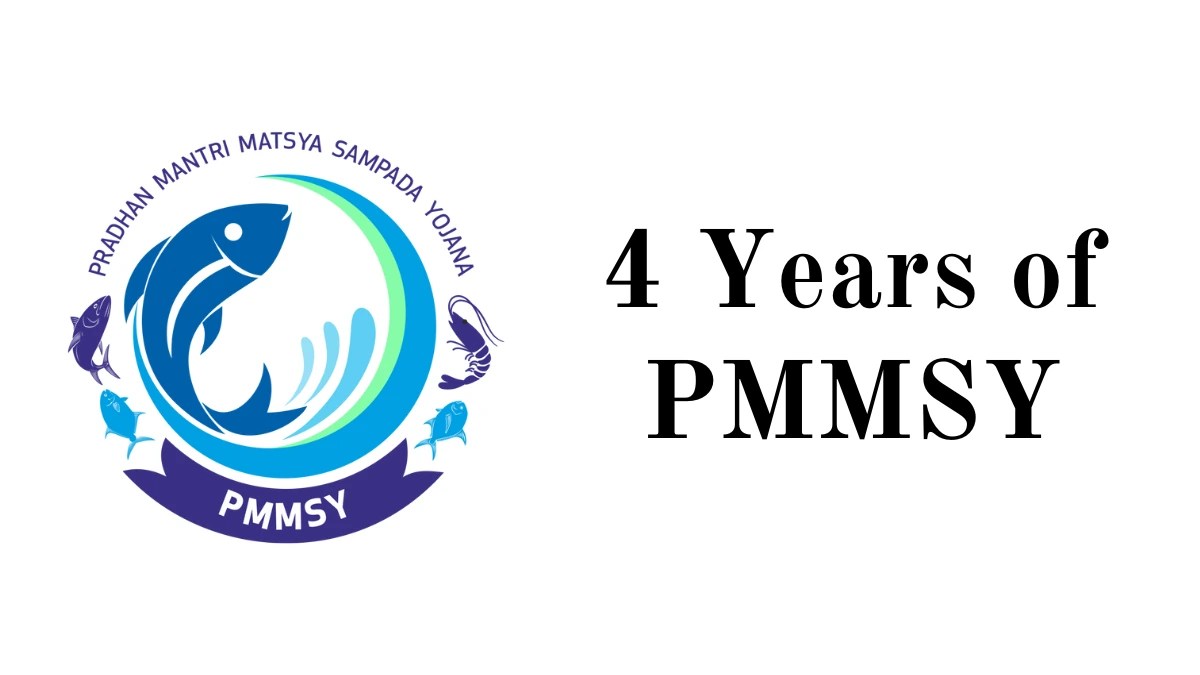
Context
Pradhan Mantri Matsya Sampada Yojana (PMMSY) has completed 4 years of Implementation.
About
- It is the flagship scheme of the Department of Fisheries, Ministry of Fisheries, Animal Husbandry & Dairying, and was launched in 2020.
- Aim: To supply momentum to the ‘sunrise’ fisheries sector through consolidated efforts from various schemes and projects.
- The PMMSY is an umbrella scheme with two separate Components particularly Central Sector Scheme (CS) and Centrally Sponsored Scheme (CSS).
- The Centrally Sponsored Scheme (CSS) Component is further segregated into Non-beneficiary orientated and beneficiary oriented subcomponents/activities:
- Enhancement of Production and Productivity
- Infrastructure and Post-harvest Management
- Fisheries Management and Regulatory Framework.
Fisheries Sector of India
- India is the third largest fish generating and second largest aquaculture generating country within the global.
- India is the 4th largest exporter of fish and fisheries products with an increase in exports of 26.73% in phrases of quantity between FY 2021-22 and FY 2022-23.
- Andhra Pradesh is the largest fish manufacturer inside the country, followed by West Bengal and Gujarat.
- In phrases of employment, the sunrise sector helps the livelihood of over 30 Mn people in India.
- The Department of Fisheries, Ministry of Fisheries, Animal Husbandry and Dairying has applied a flagship scheme “Pradhan Mantri Matsya Sampada Yojana” (PMMSY)- to result in the Blue Revolution through sustainable and accountable development of the fisheries sector in India.
Challenges of the Fisheries Sector in India
- Overfishing: Overexploitation of fish stocks due to immoderate fishing stress is a widespread venture.
- Illegal, Unreported, and Unregulated (IUU) Fishing: IUU fishing undermines efforts to manipulate and preserve fish stocks.
- It includes activities which includes fishing without proper authorization, dismissing trap limits, and the usage of banned fishing tools.
- Lack of Infrastructure and Technology: Inadequate infrastructure and old fishing generation hinder the efficiency and productivity of the fisheries sector.
- Poor storage and transportation facilities cause post-harvest losses, while outdated fishing vessels and tools restrict the capability of fishers to catch fish sustainably.
- Poor Fisheries Management: Limited enforcement of regulations, loss of comprehensive data on fish shares, and inadequate monitoring and control measures exacerbate the issue of overfishing and IUU fishing.
- Pollution and Habitat Destruction: Pollution from business activities, coastal development, and agricultural runoff poses a hazard to marine and freshwater habitats.
- Similarly, habitat destruction through activities consisting of coastal reclamation, mangrove deforestation, and dredging in addition exacerbates the lack of precious fish habitats.
- Climate Change: Climate change is altering oceanic and freshwater environments, affecting fish distribution, migration patterns, and reproductive cycles.
- Rising sea temperatures, ocean acidification, and excessive weather activities disrupt fish populations and destabilize fisheries ecosystems.
- Socio-financial Issues: Poverty, loss of opportunity livelihood alternatives, and unequal distribution of assets contribute to the vulnerability of fishing groups.
Government Initiatives for the Growth of the Sector
- National Fisheries Development Board (NFDB): Established in 2006, NFDB serves as the apex body for the planning and promoting of fisheries improvement in India.
- It implements various schemes and applications aimed at enhancing fish production, improving infrastructure, and supplying help to fishers and fish farmers.
- Blue Revolution: Launched in 2015, the Blue Revolution goals to promote sustainable improvement and management of the fisheries sector.
- It focuses on growing fish manufacturing and productivity through the adoption of modern-day technology, improving infrastructure centers, promoting entrepreneurship, and strengthening fisheries governance.
- Sagarmala Programme: The Sagarmala Programme, launched in 2015, goals to sell port-led development and unencumbered the capacity of India’s maritime sector.
- It consists of initiatives to develop fishing harbors, cold chain infrastructure, and fish processing facilities to support the increase of the fisheries sector.
- National Fisheries Policy: The Government of India formulated the National Fisheries Policy in 2020 to provide a complete framework for the sustainable improvement of the fisheries sector.
- The policy specializes in selling accountable fisheries control, keeping aquatic biodiversity, improving fish manufacturing, and improving the socio-economic fame of fishers and fish farmers.
- Fish Farmers Development Agencies (FFDAs): The Government has hooked up FFDAs at the district level to provide technical steering, education, and extension services to fish farmers.
- These companies play a vital function in disseminating knowledge about present day aquaculture practices, facilitating access to credit and inputs, and promoting entrepreneurship inside the fisheries zone.
- In order to deal with the infrastructure requirement for the fisheries sector, the union Government at some point of 2018-19 created the Fisheries and Aquaculture Infrastructure Development Fund (FIDF) with a total funds length of Rs 7522.Forty eight crore.
- In the earlier segment of implementation of FIDF at some point of the length from 2018-19 to 2022-23, a total 121 fisheries infrastructure initiatives were accepted for introduction of diverse fisheries infrastructures.
- Coastal Aquaculture Authority (CAA): The CAA regulates and promotes coastal aquaculture activities to ensure sustainable improvement and environmental conservation.
- It formulates pointers for shrimp farming, regulates using coastal land for aquaculture functions, and video display units compliance with environmental norms to prevent adverse impacts on coastal ecosystems.
Way Ahead
- The fisheries sector in India holds sizable potential for increase and development, given the country’s great coastline, several rivers, and inland water bodies.
- Measures which can in addition assist the sector:
- Strengthening monitoring and enforcement mechanisms to fight illegal, unreported, and unregulated (IUU) fishing activities.
- Providing financial help and incentives for adopting sustainable practices and modern-day technologies in fisheries.
- Ensuring the safety and restoration of aquatic habitats which includes mangroves, coral reefs, and wetlands, that are important for maintaining biodiversity and atmosphere health.
- Strengthening supply chain infrastructure and establishing higher market linkages to make sure truthful charges for fishers and access to domestic and international markets.
Source: PIB
Post Views: 850
